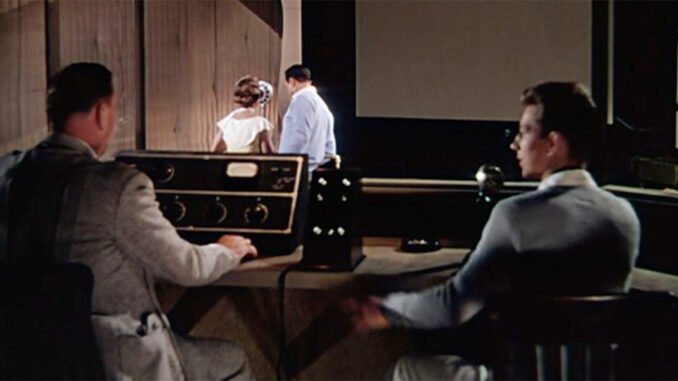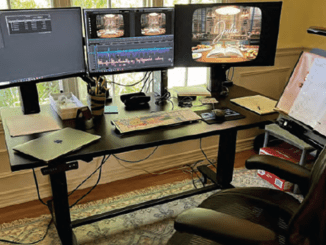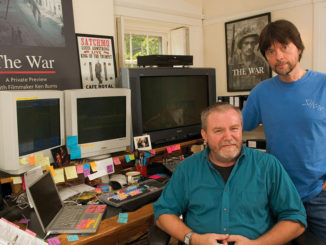
After the publication of my article, “Automatic for the People,” in the last issue of CineMontage (Q1 2017), I received a few comments, clarifications and corrections.
Regarding the photo of the ADR session for The Empire Strikes Back on Page 46, in addition to the three identified people in the foreground, ADR mixer Charleen Richards and dialogue supervisor Curt Schulkey are dimly visible in the control booth in the background.
On Page 50, I wrote about the opening of the Gordon Sawyer sound building on the Goldwyn lot back in January of 1973. All of the articles I found about the Sawyer facility spoke of the ADR stage, with the RCA control system, as if it was being used on the lot for the first time. More recently, I found an article about RCA’s AL-70 automatic looping system that appeared in the Journal of the SMPTE of October 1971. In it, author D.R. Brewer stated that Goldwyn Sound had been using RCA’s electronically controlled loop-less system since July of 1970. It must have been installed in Goldwyn’s original looping stage and then moved to the Sawyer building.
Sound editor Richard Marx, MPSE, told me that when he was at Universal, they would eliminate the leader by joining the two ends of the mag track with a twist, turning the loop into a Mobius strip.
The same article in the Journal of the SMPTE provided the answer to a question I posed about the capabilities ascribed to the RCA system. I wrote, “Another line in the description of the Goldwyn ADR system piqued this writer’s curiosity: ‘An automatic electronic pacer tone is provided which is electronically adjustable to the actor’s pace.’ What was that all about?”
It turns out that the “automatic electronic pacer tone” was a fancy term for the three-beep audio cueing for the start of a given line. Being “electronically adjustable to the actor’s pace” simply meant that the timing of the beeps (one foot apart, one second apart or some other increment) could be selected on the control panel by the operator.
Earlier in my article, I briefly described the original method of dialogue replacement involving picture and guide track, each spliced end-to-end in a loop, popularly called “looping.” From sound editor Richard Friedman came the note that prior to ADR, there was also an audio-only looping procedure for post-sync dialogue replacement recording. Called “Sound After Sound” or “Parrot Looping,” it was commonly used on episodic television series, especially at Columbia/Screen Gems and Universal Pictures.
At Columbia, the audio guide track was cut into a loop, with two feet of leader in between the end and beginning of the line. The actor would hear the line and then say the line. The two-foot gap would allow the director or editor to give instruction to the performer, such as “faster” or “louder.” Sound editor Richard Marx, MPSE, told me that when he was at Universal, they would eliminate the leader by joining the two ends of the mag track with a twist, turning the loop into a Mobius strip. The track would play the audio on one pass across the audio head and, on the next pass, only the base side would come in contact with the head. The actor would hear the line and then, while the guide track was on the base side, he would say the line. Both methods resulted in an astonishingly high number of “loops” being recorded per session.
From sound editor Richard Friedman came the note that prior to ADR, there was also an audio-only looping procedure for post-sync dialogue replacement recording.
Finally, something that is neither a correction nor a clarification, but a piece of movie lot trivia. In the sidebar “Syncin’ in the Rain” on Page 51, a screen capture of Debbie Reynolds and Gene Kelly from Singin’ in the Rain was used. However, the scene from which that image came actually started with a much wider shot (see accompanying screen capture). In it, Reynolds and Kelly can be seen in the background, and in the foreground are Donald O’Connor (as Cosmo Brown, the musical director of the film within the film) on the right, and an unknown actor on the left, playing the role of the sound engineer, who has never been identified.
For years, I just assumed that scene was filmed on a movie set, constructed on a sound stage. But when I watched the film recently, I started to suspect it might not be a set at all, but rather an actual working post-sync recording room. When I showed this screen capture to several people familiar with the facilities on the Sony lot (the former MGM lot), they all, to a person, said it looked like Foley Stage B.
So if you ever find yourself recording there, just know that you are standing where Gene Kelly most likely recorded his dance Foley!
R.J. Kizer,
Sound Editor
Valley Glen, CA





